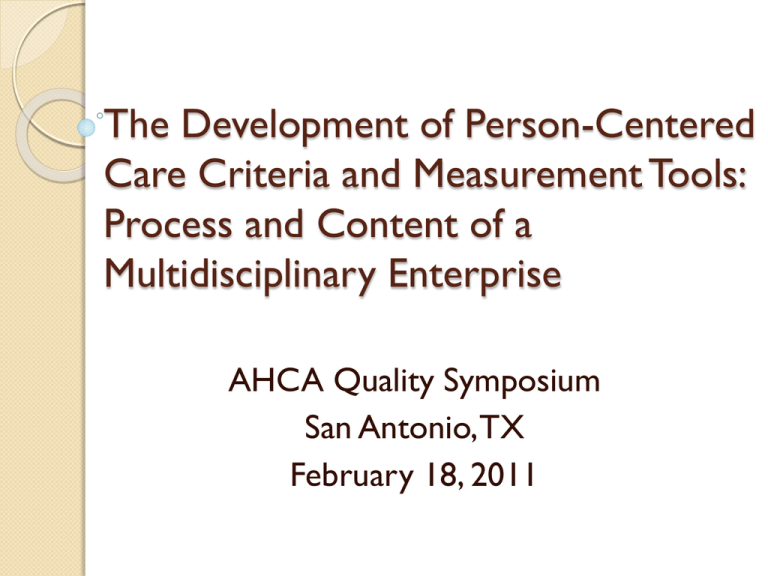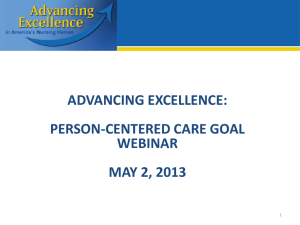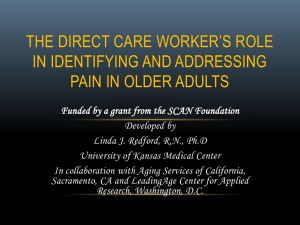The Development of Person-Centered Care Criteria and
advertisement

The Development of Person-Centered Care Criteria and Measurement Tools: Process and Content of a Multidisciplinary Enterprise AHCA Quality Symposium San Antonio, TX February 18, 2011 Michael Lepore, PhD Director of Quality, Research, & Evaluation Planetree mlepore@planetree.org & Investigator in Community Health Brown University michael_lepore@brown.edu Collaborators Planetree • Heidi Gil • Susan Frampton, PhD • Christy Davies • Affiliate sites Brown University My InnerView IDEAS Institute • Susan Miller, PhD • Michael Lepore, PhD • Vivian TellisNayak, PhD • Mary TellisNayak • Maggie Calkins, PhD • Jennifer Brush Research Support The Commonwealth Fund ◦ Developing Systems to Support Person-Centered Care: Optimizing Planetree’s Continuing Care Designation Criteria and Measurement Strategies A note on language For the purpose of this presentation, the terms person-centered care and person-centeredness are used, though other terms also are recognized (patient-centered, resident-centered, family-centered, relationship-centered, etc.) Outline Person-centered care (PCC) criteria and measures ◦ Why develop PCC criteria and measures? ◦ How were PCC criteria and measures developed? ◦ What are the PCC criteria and measures? ◦ How can we use the PCC criteria and measures? Why develop PCC criteria and measures? Why develop PCC criteria and measures? The Institute of Medicine identified PCC as a healthcare priority What is person-centered care? ◦ “health care that establishes a partnership among practitioners, patients, and their families (when appropriate) to ensure that decisions respect patients wants, needs, and preferences and that patients have the education and support they require to make decisions and participate in their own care.” (IOM, 2001, Envisioning a National Healthcare Quality Agenda) Why develop PCC criteria and measures? PCC is a complex concept requiring multiple dimensions of culture change MJ Koren (2010). PersonCentered Care For Nursing Home Residents: The Culture-Change Movement. Health Affairs, 29: 312-317 Homelike atmosphere Resident direction Close relationships PCC Qualityimprovement processes Staff empowerment Collaborative decision making Why develop PCC criteria and measures? Benchmark performance internally / longitudinally Benchmark performance externally / in comparison to competitors Understand relationship between PCC and other factors (e.g., financial, regulatory performance) Why develop PCC criteria and measures? Long-term care executives call for new measures ◦ “I think measurement is key. We have to develop new measurements if we want new outcomes. And people pay attention to what we’re measuring, and many of the current measurements are still good, but we need additional measurements.” Long-Term Care Improvement Guide (available for free download at www.planetree.org) How were PCC criteria and measures developed? How were PCC criteria developed? Step 1 Step 2 Step 3 • Preliminary criteria developed through focus groups and expert committee from Planetree, My InnerView, IHI, Joint Commission, etc • Preliminary criteria crosswalked with PCC measurement tools & literature (evidence base) • Recommendations made for revision (e.g., drop, add, merge, split) • Criteria revisions reviewed by research team & representatives from affiliated LTC sites • Consensus on criteria established Original A plan for caring touch is developed and implemented as appropriate. (Exceptions include behavioral health patients.) Examples of caring touch include massage, healing touch, therapeutic touch and Reiki. Related Measurement or Literature CAHPS Resident Surveys: What number would you use to rate how gentle the nursing home staff were when they helped you? Revised …Beyond implementation of formal caring touch programs, patients’/residents’ daily care is provided with gentleness. Multi-Method Evaluation Protocol Self Assessment Focus Groups Quality Profile (QP) Satisfaction Survey How were PCC measures developed? Step 1 • Preliminary Quality Profile measures suggested based on review of existing satisfaction and PCC measurement tools and literature Step 2 • Providers interviewed about measurement needs and surveyed about feasibility and importance of preliminary measures Step 3 • Measures reviewed by research team & representatives from affiliated provider sites • Consensus reached on Quality Profile measures Originally % of residents who did not die alone (some one Recommended was within 10 feet some time during the last Measure hour) during the month Response from Providers Revised Measure Nursing home Importance 2.25 Feasibility 3.57 Assisted living 3 1 (Not at all) (Very) 1-----------------------------------------------------5 % of residents who died in place (not transferred to the hospital in the 7 days prior to death) What are the PCC criteria and measures? What are the PCC criteria? Criterion 3 Eleven core Components each with specific criteria Criterion 2 Component Criterion 1 Planetree Components of Person-Centered Care Component I. Structures & Functions Necessary for Implementation, Development & Maintenance of Resident-Centered Concepts & Practices Component V. Nutrition Program Component II. Human Interactions / Independence Dignity & Choice Component VIII. Spirituality & Diversity Component III. Resident Choice & Responsibility Component IV. Family Involvement Component VI. Healing Environment: Architecture & Design Component VII. Arts Program / Meaningful Activities / Entertainment Component IX. Integrative Therapies / Paths to Well-Being Component X. Healthy Communities / Enhancement of Life's Journey Component XI. Measurement What are the PCC criteria? A multi-disciplinary task force oversees resident-centered practices Residentcentered care coordinator is designated I. Structures & Functions Resident, family & staff focus groups are conducted periodically What are the PCC criteria? A comprehensive presentation on PCC concepts, practices & initiatives is provided for all new staff & residents as a part of orientation Staff have the opportunity for personalizing care in partnership with each resident II. Human Interactions Numerous opportunities are provided for staff celebration, reward & recognition What are the PCC criteria? Residents are provided with meaningful discharge/ transition instructions A process is in place for sharing clinical information, including the medical record & care plan, with residents III. Resident Choice & Responsibility A process is in place to fully disclose & apologize for unanticipated outcomes to residents What are the PCC criteria? A process aligned with each resident’s preferences is in place to contact family to communicate progress Partner with families in all aspects of residents’ care IV. Family Involvement Flexible, 24hour, residentdirected visiting hours What are the PCC criteria? 24-hour access to a variety of foods & beverages Fresh, healthy food at appropriate temperatures, & a variety of food choices V. Nutrition Program Residents have opportunities to participate in meal planning What are the PCC measures? Quality Profile (QP) includes quantitative metrics for evaluating an organization’s performance with regard to important elements of PCC as identified in the literature and from providers ◦ QP to be completed on last Friday of month What are the PCC measures? The measures, like the criteria, are designed to teach and to motivate, not merely to avoid lapses in quality ◦ They beckon affiliates to rise up to the challenge and to reach for excellence ◦ Some measures relate to specific criteria, and some are more global (e.g., relating to org. health) A multi-disciplinary task force is established to oversee and assist with implementation and maintenance of patient-/resident-centered practices, which includes a mix of nonsupervisory and management staff, including a Criterion combination of clinical and non-clinical staff, and meets regularly (every 4-6 weeks) on an ongoing basis. In continuing care environments, this task force also includes residents and family members. Measure Numerator: Cumulative meetings this year Denominator: Data month (1-12) Processes are in place for evaluating, identifying and effectively integrating into the care plan what is important to each resident, based on Criterion his/her identity, decision-making ability, and mastery skills, and what is meaningful to that resident in the living environment and in daily activities. Measure % of care plans completed in which the resident participated A model of care delivery or work design is adopted that embraces continuity, consistency and accountability-based care, and allows staff Criterion the opportunity and responsibility for personalizing care in partnership with each patient/resident. Measure % of care plans completed in which a CNA participated A comprehensive formalized approach for partnering with families in all aspects of the patient’s/ resident’s care, and tailored to the Criterion needs and abilities of the organization and its facility, is developed. An example is a Care Partner Program. Measure % of care plans in which families participated Residents are given an opportunity to participate, as appropriate, in a retreat experience or an equivalent to assist with Criterion internalizing resident-centered care concepts and to enhance sensitivity to the needs of the entire community. Resident retreats are conducted at a minimum annually. Measure % of residents that have completed the retreat Criterion A flexible transportation system is provided that enables residents to satisfy personal wishes, to participate in off-site activities and to volunteer. Measure % of residents (who are not unable to leave site due, for instance, to health) participating in off-site activities promoting personal growth, such as volunteering, political or religious activities, arts and leisure, etc Criterion Leadership includes approaches that motivate and inspire others, promote positive morale, mentor and enhance performance of others, recognize the knowledge and decision-making authority of others and model organizational values. Measure % of supervisors that are specifically trained to mentor on the person-centered approach. Criterion All staff, including off-shift, part-time, prn, providers and support staff are given an opportunity to participate in a minimum of eight hours of patient-/resident-centered staff retreat experiences or an equivalent, with a minimum concurrent completion rate of 85%. Measure % of staff that have completed the retreat Criterion Continuing education to reinforce and revitalize staff engagement in patient/resident-centered behaviors and practices and build competence around the community’s evolving needs is offered on an ongoing basis to all staff in meaningful ways determined by the organization. Numerator: Measure # of staff who have been participated in advanced training opportunities Denominator: Total # of staff Residents’ wellness needs are approached holistically. Examples include the provision of wellness programs, such as nutrition counseling and stress management and implementation of (or access to) programs that support residents in Criterion chronic disease management. Residents have convenient access to physical and mental fitness opportunities, as well as to podiatry, vision, hearing, and dental services, and psychological and pharmaceutical consultation. Measure % of residents that participated in one or more organized wellness activities Additional PCC measures Measures broadly related to PCC, but not tied to specific criteria Concept Measure Staff Empowerment % of new employee interviews in which line staff participate (dietary, housekeeping, CNA) Resident Empowerment % of CNA hiring decisions made in which a resident participated Resident Health % of residents that participated in one or & Wellness more organized wellness activities Concept Measure End of Life Care % of residents with advance care wishes documented End of Life Care % of residents who died in place (not transferred to hospital in the 7 days prior to death) Emotional Support Services # of events for residents that specifically and primarily address topics of loss (e.g., loss of mobility/driving, vision or hearing; grief management; mental status changes; incontinence) Concept Measures % of nursing shifts (RN, LPN, CNA) covered by agency staff % of staff consistently assigned to the same residents (Advancing Excellence measure) Consistent Care Turnover of staff •Voluntary •Involuntary Absenteeism: %of nursing staff who did not report to work as scheduled Concept(s) Measure Organizational Stability Tenure of DON(s) Organizational Stability Tenure of Administrator(s) Organizational Stability & Consistent Care Tenure of nursing staff (average months of service of all nursing staff) Concept Measure Organizational Health Occupancy rate (Census): % of units/apartments that are occupied Organizational Health # of vacant positions Organizational Health # of staff injuries Summary Person-centered care criteria established through review of literature and provider experiences and views Multi-method system for evaluating personcentered care established Quantitative instrument for measuring person-centered care established Next Steps Identify sites to formally pilot measures ◦ Provide sites data collection measurement guides (e.g., worksheets for measures) ◦ Provide sites mentoring in data use Test measurement instrument ◦ Validity, Reliability, Harmonization/Transportability For guidance in achieving person-centered care, the Long Term Care Improvement Guide is available for free download at http://www.planetree.org Questions: mlepore@planetree.org









